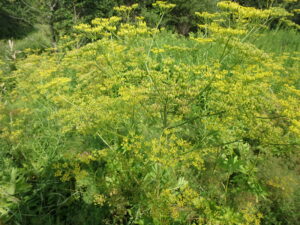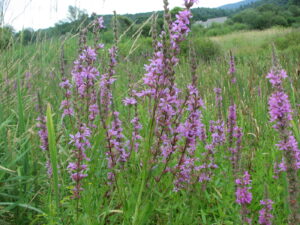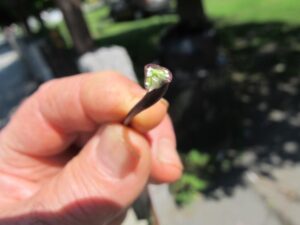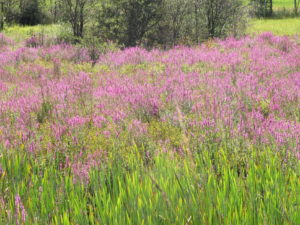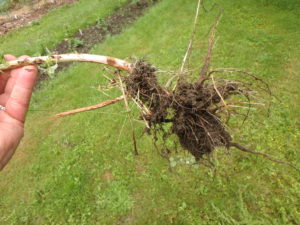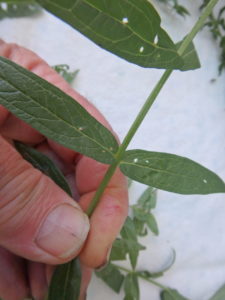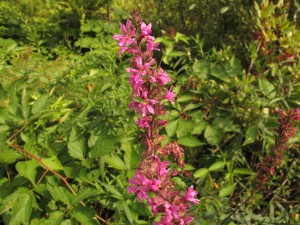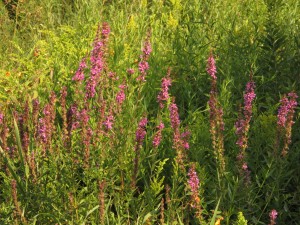Three Plants to Avoid
Learn what it looks like, and avoid it. Sap from the stem, if on the skin and exposed to direct sunlight, can cause horrible burns. Not everyone reacts, however. Assume you do. If you get sap on you, go inside IMMEDIATELY and wash the affected area thoroughly.
First or second year plants often show up in my garden near my stream, but can be hand-pulled. Look for plants with a square stem that quickly get 18 to 24 inches tall, and may have a reddish-brown tinge to their stems. Older plants get to be 3 to 7 feet tall or more. Leaves are long and narrow with a smooth edge, and they attach directly to the stalk – without an attachment stem. Leaves generally appear in pairs, across from each other on a stalk. Many flower stems arise from the main stem.
The most popular Norway maple is a cultivar called “Crimson King’. It has leaves that are a deep purple – almost black. Many cities and homeowners bought these 50 years ago and installed them. Removing them is difficult and expensive.
The leaves are a bit bigger and wider than sugar maples, but you can I.D. a Norway maple by picking a leaf. Look at the place where it snapped off: if it oozes a white sap, it is a Norway maple. If you have one, please consider having it removed. Your great grandchildren’s maple syrup depends on it!
Beware the Purple Invader
This is the time of year when swampy areas often are ablaze with gorgeous pink-purple flowers that dominate the wetland. These are the flowers of purple loosestrife (Lythrum salicaria), an invasive plant that you should not encourage – but that you probably can’t get rid of once established.
Most invasive plants come from another continent, start easily from seed, are difficult to eradicate, and often have no natural predators away from their homeland. That is certainly true of purple loosestrife.
But why worry about this purple invader? It’s such an aggressive grower that it out-competes native plants. It moves into shallow wetlands where fish and frogs lay their eggs among native plants, creating a dense mono culture. Biodiversity is healthy for the environment, and purple loosestrife inhibits many other kinds of plants from growing.
Mature plants develop massive root systems that will challenge even the strongest backs so they can’t be dug out. They also develop long side-roots that will easily break off and start new plants if you try to remove the clumps.
A big clump can produce up to 2.7 million seeds in a year. And like time-release cold capsules, the seeds become active over time, not all in one year. And since they grow in wetlands, you can’t use herbicides. So what can you do? There are steps you can take to reduce the problem.
If you have big, established plants the best thing to do is cut them down multiple times each summer, just above the soil line. This will prevent them from flowering and producing seeds. It will also reduce the vigor of the plants. It won’t kill them, so this is a lifetime job, like it or not. A string trimmer will do the job, if you have one.
You can, however, pull out or dig out first or second year plants, so need to be able to identify them. Look for plants with a square stem that quickly get 18 to 24 inches tall, and may have a reddish-brown tinge to their stems. Older plants get to be 3 to 7 feet tall or more. Leaves are long and narrow with a smooth edge, and they attach directly to the stalk – without an attachment stem. Leaves generally appear in pairs, across from each other on a stalk. Many flower stems arise from the main stem.
There is, perhaps, relief in sight. In some states, including Rhode Island, Connecticut and Massachusetts in New England, have programs to introduce non-native beetles that will eat the purple loosestrife. Two beetles, Galerucella calmariensis and Galerucella pusilla, have been introduced and found effective in reducing stands of loosestrife.
Will those beetles eat your peonies or tomatoes? No. The process for introducing a new species is carefully regulated by our government to protect our crops and gardens from new pests. These two species of beetles were tested on many crops while kept in quarantine before being released. They specifically eat purple loosestrife, but not other plants.
The beetles will never completely eradicate loosestrife. As loosestrife populations dwindle, so do numbers of the beetles. If the loosestrife starts to spread, the number of beetles rebounds. The bad news? You can’t buy these beetles. I’m not sure why.
Purple loosestrife, like most problem plants, is from another continent – in this case, Europe and Asia. I’ve read that the seeds of purple loosestrife probably came on sailing vessels that used sand or soil as ballast to balance their loads in the 18th century. That soil was dumped on arrival and a few seeds found a foothold. Without any natural predators, the plants spread.
Birds are often agents of distribution of seeds of invasive plants. They eat the seeds, which are often covered with a non-digestible outer coating. The birds get little benefit, and the seeds are distributed to new locations. Waterfowl can carry seeds on their feet. So even if you don’t care about loosestrife on your land, or think it is pretty, be aware that leaving it to bloom and go to seed means that it will spread to other areas. You are doing a service to the environment if you inhibit the loosestrife from spreading.
Storm drains are another vector for spreading invasives, particularly in cities. Rains wash seeds into the drains, which take the water to a river or wetland which then spreads them further. So even if you live in a city, try to rid yourself of invasive plants like purple loosestrife. Each state has a list of prohibited plants that is available, with pictures, on-line.
I was shocked to read that seeds for purple loosestrife on-line. Most nurseries stopped selling them decades ago. And even if a cultivar is listed as “sterile”, I wouldn’t buy any. The chances of non-sterile seeds arriving in the mix are too great. Purple loosestrife is a plant I really don’t want in my garden – or yours!
I am hoping to help lead a Viking River Cruise next June from Paris to Normandy and back with stops along the way – including Monet’s magical garden, Giverny. If there is enough interest, we might have 3 days in Paris looking at gardens there. If you are interested, e-mail me at henry.homeyer@comcast.net.
Dealing with Invasives
I’m sure you know purple loosestrife, even if you don’t know its name. It’s a big, tall clumping plant bearing bright pinkish-purple flowers and it’s appearing now in your neighborhood, especially in wet areas. What you may not know is that it’s an aggressive foreign invader that can out-compete many of our native species. It has been around for a couple of centuries – it came over, allegedly, in soil used as ballast in sailing vessels in the late 1700’s.
But if it grows well and it’s pretty, what’s the problem, you may wonder? A number of things. It’s a big plant that can dominate the landscape and shade out smaller, less vigorous native plants. A mature loosestrife can produce up to a million seeds, seeds that can be carried by streams to new locations. Wildlife can be negatively impacted. Many insects and birds depend on native plants for food and nesting materials- native plants that evolved with them. Invasives like purple loosestrife often do not meet their needs.
According to Barbara McIlroy of Etna, NH, who has been active in the movement to control invasive species, the number of bird and butterfly species present on properties that grow native species is much, much higher. “I’m converted,” she told me. “Grow natives. Period. The positive effect on the wildlife is dramatic.”
Unfortunately, it’s almost impossible to rid your property of purple loosestrife. These plants have amazingly tenacious roots. Before I knew better I tried digging out some large plants from a swampy area on my property. Yes, I got the plants out – but some of the roots broke off and re-sprouted. And by clearing out a space, I also opened up a new site for seeds to grow. If you have had purple loosestrife in the past, there are seeds waiting for a chance to germinate – like little time bombs.
But there is good news: two species of beetle (Galerucella calmariensis and G. pusilla) have been approved for and found effective in controlling purple loosestrife. These beetles cannot eliminate the loosestrife, but can reduce the numbers dramatically. Loosestrife is not a problem in Europe the way it is here, in part because it has natural enemies – the beetles. By introducing the beetles, an effort has been made to help Mother Nature keep loosestrife under control. Once established, they eat enough of the leaves and stems that the plants do not bloom. And theses beetles have been well tested: they will not eat your garden plants or valuable crops.
In 2001 Saint-Gaudens National Historic Site in Cornish, NH released two species of beetles to see if they could control the purple loosestrife that was taking over the wetlands at Blow-Me-Down pond. I met recently with Steve Walasewcz, who monitored the effort from 2001 to 2008. He explained that the beetles did not have an immediate effect. In fact, from 5.75 stems per square meter in 2001, the numbers increased to 10.5 by 2003. But then they declined each year until reaching only 1.05 in 2008 – a tenth the number of stems.
I went to the area where the beetles were released in 2001 and although there were a few blooming stems of purple loosestrife, there were very few. According to a report done for Saint-Gaudens NHS, it is believed that even low numbers of beetles prevent flowering; at higher numbers, “the beetles can strip the plants of its photosynthetic layer, resulting in high mortality in the winter due to a depleted starch reserve.”
Unfortunately, the beetles are not readily available for purchase. But for several years I have been experimenting with my own way of controlling the problem near my brook. Each year in early July I take pruners and cut back the plants to the ground. I identify them by their square stems that have a reddish color near the ground, and of course their leaves. Then a month later, I do it again – in essence, acting like a beetle. By cutting back the plants, few are able to bloom, greatly reducing the number of seeds spilling into my environment.
As a second step, I planted some big, tall native plants that I hoped would compete with the purple loosestrife: Joe Pye weed (Eupatorium purpureum) and Canadian burnet (Sanguisorba canadensis). I also added marsh marigold (Caltha palustris), which though not tall, is tough. These natives have given purple loosestrife a run for its money. Instead of filling 3 wheelbarrows with cut loosestrife in early July, I was able to get it all in one.
Purple loosestrife is just one of many invasive plants. If you see a new, vigorous plant show up on your property, try to learn its name and find out if it’s a problem elsewhere. Meanwhile, there is good news: scientists are working on biological controls for both Japanese knotweed (commonly called bamboo) and garlic mustard. In England, certain beetles are now well established to reduce the vigor of Japanese knotweed.
Henry Homeyer is the author of 4 gardening books and a new children’s fantasy-adventure about a boy and a cougar. His web site is www.Gardening-guy.com.



